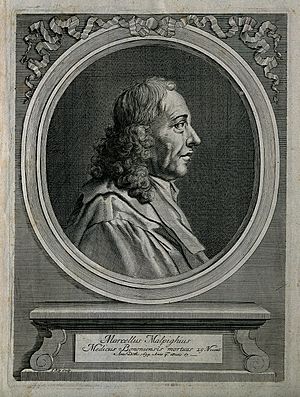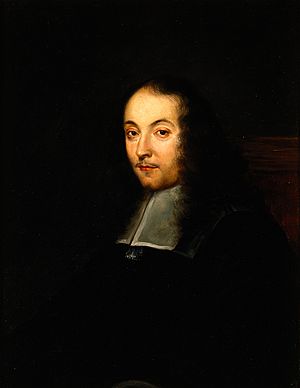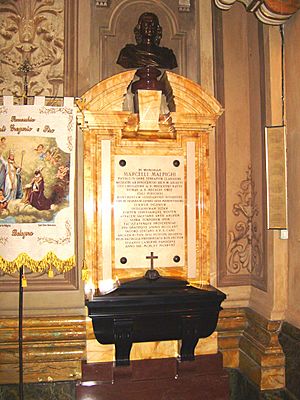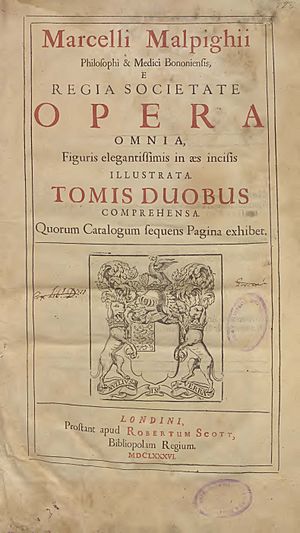Marcello Malpighi facts for kids
Quick facts for kids
Marcello Malpighi
|
|
|---|---|

Marcello Malpighi, a lifetime portrait by Carlo Cignani
|
|
| Born | 10 March 1628 Crevalcore, Papal States
|
| Died | 30 November 1694 (aged 66) |
| Nationality | Italian |
| Alma mater | University of Bologna |
| Scientific career | |
| Fields | Anatomy, histology, physiology, embryology, medicine |
| Institutions | University of Bologna University of Pisa University of Messina |
| Doctoral advisor | Giovanni Alfonso Borelli |
| Doctoral students | Antonio Maria Valsalva |
Marcello Malpighi (born March 10, 1628 – died November 30, 1694) was an Italian biologist and physician. He is often called the "Founder of microscopical anatomy, histology & Father of physiology and embryology." Malpighi was the first person to see tiny blood vessels called capillaries in animals. He also discovered how arteries and veins are connected, which was a big step for understanding blood flow.
Malpighi was one of the first people to look at red blood cells using a microscope. He also wrote about how blood clots form. His work helped scientists understand what blood is made of.
Using his microscope, Malpighi found that insects don't breathe with lungs. Instead, they use small holes in their skin called tracheae. He also studied the brain and thought it was a type of gland. This idea was actually correct, as parts of the brain do release hormones.
Malpighi knew a lot about both plants and animals. He made important discoveries in both fields. The Royal Society in London published many of his works. He even said his book Anatome Plantarum was "the most elegant" book in the world.
His studies of plants showed him that plants have tiny tubes, similar to those he saw in insects. He probably saw stomata, which are tiny pores plants use to exchange gases. Malpighi also noticed that if a ring of bark was removed from a tree, the part above the ring would swell. He correctly figured out this was because food from the leaves was blocked from moving down.
Contents
Early Life and Education
Marcello Malpighi was born on March 10, 1628, in Crevalcore, near Bologna, Italy. His parents were well-off. He started studying at the University of Bologna when he was 17.
Malpighi studied philosophy and then physics. When his parents and grandmother became sick, he went home to care for them. In 1653, he earned degrees in both medicine and philosophy. He became a medical doctor at age 25.
Even though some university officials didn't like him because he wasn't from Bologna, he became a teacher. He loved both scientific research and teaching. In 1667, he was invited to join the Royal Society in London, and he became a member the next year.
In 1656, Malpighi was asked to teach medicine at the University of Pisa. There, he became good friends with Giovanni Borelli, a mathematician. Malpighi started questioning old medical ideas and did experiments. He tried to solve problems in anatomy and medicine.
He returned to the University of Bologna in 1659 due to family reasons and poor health. He kept teaching and doing research with his microscopes. In 1661, he found and described the tiny network of capillaries that connect small arteries and veins in the lungs. His new ideas sometimes caused arguments with other doctors.
Discoveries and Career
After his parents and grandmother passed away in 1653, Malpighi went back to the University of Bologna to study anatomy. In 1656, he became a professor at Pisa. There, he started using experiments more in his research instead of just debating ideas.
He later returned to Bologna in 1660 and focused on anatomy. He discovered new structures in the lungs. In 1662, he became a professor at the Academy of Messina.
In 1663, Malpighi left university life and went to his country home near Bologna. He worked as a doctor and kept doing experiments on plants and insects. He made discoveries about plant structures, which he wrote about in his Observations.
In 1668, Malpighi received a letter from the Royal Society in London. They invited him to share his work. He sent them his writings about the silkworm in 1668. Because of this, he became a member of the Royal Society in 1669.
In 1671, his book Anatomy of Plants was published in London. He also told the Royal Society about his new discoveries regarding the lungs, spleen, brain, and sensory organs. He shared more information about his plant research too.
Malpighi continued his research and published many works. In 1691, Pope Innocent XII invited him to Rome. He became the Pope's doctor and a professor of medicine. He stayed in Rome until he passed away.
Marcello Malpighi is buried in the church of Santi Gregorio e Siro in Bologna. There is a marble monument there that honors his "great genius, honest life, strong and tough mind, daring love for the medical art."
Amazing Research with Microscopes
Around age 38, Malpighi decided to spend his free time studying anatomy. He used both dissections and vivisection (studying living animals). But his most important work came from using the microscope. Because of his work, many tiny parts of the body are named after him. These include a skin layer, parts of the kidneys and spleen, and tubes in the excretory system of insects.
Microscopes had been invented earlier, but their full potential wasn't used until Malpighi and others improved them. Malpighi, along with Robert Hooke, Nehemiah Grew, and Antoine van Leeuwenhoek, were lucky to have this new tool for their studies.
Discovering Capillaries and Blood Flow
In 1661, Malpighi saw tiny capillaries in the lungs of frogs. He had tried to study blood flow in larger animals like sheep, but the capillaries were too small to see. Frogs were the perfect size.
By seeing capillaries in frog lungs, Malpighi studied how blood moves in a closed system. Before this, many thought blood just pooled in open spaces in the body. His discovery of capillaries showed how veins and arteries are connected. This helped prove William Harvey's idea that blood circulates in a closed loop.
Malpighi also looked closely at the lungs. He saw that the airways branched into tiny, thin-walled sacs. He compared them to honeycomb holes surrounded by capillaries. These lung structures are now called alveoli. He explained how air and blood mix in the lungs. He also used the microscope to study the skin, kidneys, and liver. For example, he studied the skin of a black person and found that the dark color came from a layer of mucus just under the skin.
Studying the Nervous System
From 1663 to 1667, Malpighi focused on the human nervous system. He found and described nerve endings, the structure of the brain, and the optic nerve. He published his work on the nervous system in three books in 1665.
In his work on the tongue, he discovered small bumps called "papillae," which are taste buds. He described how they connect to nerve endings to give us the sense of taste. He also studied the brain, trying to map its gray and white tissues. He thought there was a connection between the brain and spinal cord through nerves.
Plant Life and Development
Malpighi's work on plant anatomy started when he saw an interesting structure in a chestnut tree branch. This structure is now known as xylem. He looked at xylem in different plants and noticed it was arranged in rings or scattered groups in the stem. This difference is still used today to classify major plant families.
Malpighi was a skilled artist and drew detailed pictures of flower parts. In his Anatome Plantarum, he drew a flower of Nigella (a type of honey-flower). He showed the parts that produce nectar.
He was also good at tracing how plant organs develop. He studied how seedlings grow, especially beans and squash. In 1679, he published a book with beautiful drawings of these stages. Later, he drew the development of the date palm. The famous botanist Carl Linnaeus named the plant genus Malpighia after him, honoring his work with plants.
Malpighi also studied teratology, which is the study of unusual development. He disagreed with the idea that insects were born from galls (swellings) on trees. He correctly guessed that the insects came from eggs laid in the plant tissue.
Reproduction and Life Cycles
Malpighi's studies of plant and animal life cycles led him to study reproduction. He made detailed drawings of chick embryo development, starting from just 2-3 days after fertilization. His drawings focused on how limbs and organs developed over time.
He also studied seed development in plants, like the lemon tree, and how caterpillars change into insects. Malpighi even thought about how human embryos grow. He suggested that all parts of the circulatory system would develop at the same time in an embryo. His discoveries helped scientists understand ideas about how living things form and change.
Later Years in Rome
In 1691, Pope Innocent XII invited Malpighi to Rome to be his personal physician. He also taught medicine at the Papal Medical School. He wrote a long book about his studies and gave it to the Royal Society of London.
Marcello Malpighi passed away in Rome on November 30, 1694, at age 66, from a stroke. As he wished, an autopsy was performed. The Royal Society published his final studies in 1696. An asteroid, 11121 Malpighi, is named in his honor.
Important Works by Malpighi
- Anatome Plantarum (1675 and 1679): A detailed study of plants.
- De viscerum structura exercitatio (On the structure of organs)
- De pulmonis epistolae (Letters on the lungs)
- De polypo cordis (1666): About blood clots in the heart.
- Dissertatio epistolica de formatione pulli in ovo (1673): A letter about the development of a chick in an egg.
Images for kids
-
Marcello Malpighi, a lifetime portrait by Carlo Cignani
See also
 In Spanish: Marcello Malpighi para niños
In Spanish: Marcello Malpighi para niños










